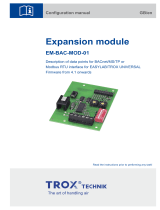3.19. Freeze a Screen ........................................................................................................................................... 19
3.20. Freeze a Layer ............................................................................................................................................. 20
4. Multiviewer commands .......................................................................................................................................... 21
4.1. Reading the Multiviewer output information ............................................................................................. 21
4.2. Recalling a Multiviewer Preset .................................................................................................................... 22
4.3. Reading the source of a Multiviewer output widget .................................................................................. 22
4.4. Reading the status of a Multiviewer output widget ................................................................................... 22
4.5. Changing a Multiviewer widget source ....................................................................................................... 22
5. Audio commands .................................................................................................................................................... 24
5.1. Output / Screen / Auxiliary screen .............................................................................................................. 24
5.1.1. Reading the Output audio mode ............................................................................................................ 24
5.1.2. Reading the Screen audio mode ............................................................................................................. 24
5.1.3. Reading the Auxiliary screen audio mode .............................................................................................. 25
5.1.4. Changing an Output audio source .......................................................................................................... 25
5.1.5. Changing a Screen audio source ............................................................................................................. 26
5.1.6. Changing an Auxiliary Screen audio source ............................................................................................ 27
5.1.7. Reading the Output audio source ........................................................................................................... 29
5.1.8. Reading the Screen audio source ............................................................................................................ 29
5.1.9. Reading the Auxiliary screen audio source ............................................................................................. 30
5.1.10. Mute an Output ...................................................................................................................................... 31
5.1.11. Mute a Screen ......................................................................................................................................... 31
5.1.12. Mute an Auxiliary .................................................................................................................................... 32
5.1.13. Mute a Input channel .............................................................................................................................. 32
5.2. Multiviewer ................................................................................................................................................. 32
5.2.1. Reading the Multiviewer output audio mode......................................................................................... 32
5.2.2. Reading the Multiviewer screen audio mode ......................................................................................... 33
5.2.3. Changing a Multiviewer output audio source ......................................................................................... 33
5.2.4. Changing a Multiviewer screen audio source ......................................................................................... 34
5.2.5. Reading the Multiviewer output audio source ....................................................................................... 35
5.2.6. Reading the Multiviewer screen audio source ....................................................................................... 35
5.2.7. Changing the active VU meter widget .................................................................................................... 36
5.3. Dante (Optional) ......................................................................................................................................... 36
5.3.1. Reading a Dante output audio mode ...................................................................................................... 36
5.3.2. Changing a Dante output audio source .................................................................................................. 37




















